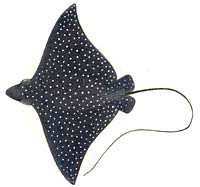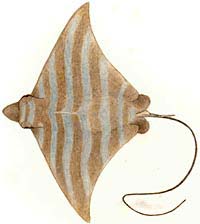|
Myliobatidae (eagle rays)
Life
> Eukaryotes >
Opisthokonta
> Metazoa (animals) >
Bilateria >
Deuterostomia > Chordata >
Craniata > Vertebrata (vertebrates) > Gnathostomata (jawed
vertebrates) > Chondrichthyes > Elasmobranchii > Batoidei >
Myliobatoidei
These large, heavy-bodied rays have thick,
broad heads that protrude from the disk outline, rounded fleshy
snouts, angular pectoral disks, a single dorsal fin near the pelvic
fins, and long slender whiplike tails with a small sting. All are
active swimmers, and some readily leap into the air. Their massive
jaws have rows of flat crushing teeth forming a tooth plate in each
jaw, which can crack and grind thick-shelled mollusks. The thick
flexible snout is used like a pig's nose, to root out prey on the
bottom. 23 species, 4 in the area.
Species found in Southern Africa
|
Aetobatus narinari (Spotted eagleray or
bonnetray) A thick-headed eagleray with many small white
spots or rings on its black or bluish disk, a long rounded flat
snout like a duck's bill, sharply curved angular corners on pectoral
disk, and normally a single row of flat, chevron-shaped teeth.
Underside white. |
 |
|
Aetomylaeus
vespertilio (Ornate or reticulate eagleray) |
|
|
Pteromylaeus bovina (Duckbill ray) A thick-headed eagleray with several pale
blue-grey stripes across its light brown disk, a long rounded flat
snout like a duck's bill, sharply curved angular corners on pectoral
disk, and normally 7 rows of flat teeth. Stripes sometimes absent,
underside white. |
 |
Text by Leonard J.V. Compagno, David A. Ebert
and Malcolm J. Smale
|
